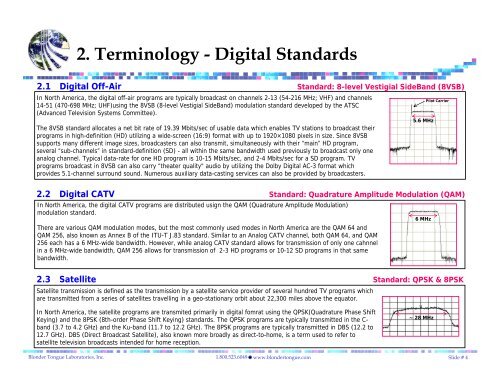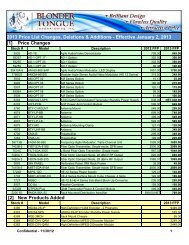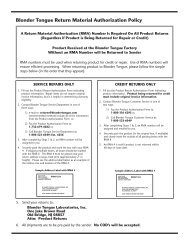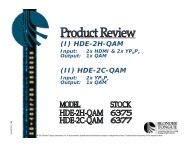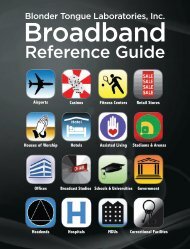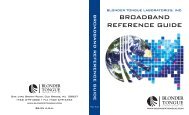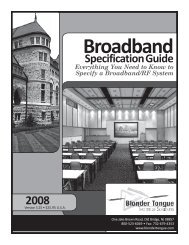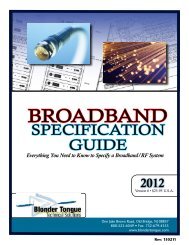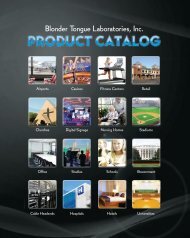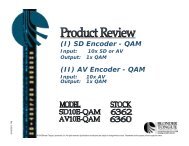US Digital Transition - Blonder Tongue Laboratories Inc.
US Digital Transition - Blonder Tongue Laboratories Inc.
US Digital Transition - Blonder Tongue Laboratories Inc.
Create successful ePaper yourself
Turn your PDF publications into a flip-book with our unique Google optimized e-Paper software.
2. Terminology - <strong>Digital</strong> Standards<br />
2.1 <strong>Digital</strong> Off-Air Standard: 8-level Vestigial SideBand (8VSB)<br />
In North America, the digital off-air programs are typically broadcast on channels 2-13 (54-216 MHz; VHF) and channels<br />
14-51 (470-698 MHz; UHF)using the 8VSB (8-level Vestigial SideBand) modulation standard developed by the ATSC<br />
(Advanced Television Systems Committee).<br />
The 8VSB standard allocates a net bit rate of 19.39 Mbits/sec of usable data which enables TV stations to broadcast their<br />
programs in high-definition (HD) utilizing a wide-screen (16:9) format with up to 1920×1080 pixels in size. Since 8VSB<br />
supports many different image sizes, broadcasters can also transmit, simultaneously with their “main” HD program,<br />
several “sub-channels” in standard-definition (SD) - all within the same bandwidth used previously to broadcast only one<br />
analog channel. Typical data-rate for one HD program is 10-15 Mbits/sec, and 2-4 Mbits/sec for a SD program. TV<br />
programs broadcast in 8VSB can also carry “theater quality" audio by utilizing the Dolby <strong>Digital</strong> AC-3 format which<br />
provides 5.1-channel surround sound. Numerous auxiliary data-casting services can also be provided by broadcasters.<br />
5.6 MHz<br />
Pilot Carrier<br />
2.2 <strong>Digital</strong> CATV Standard: Quadrature Amplitude Modulation (QAM)<br />
In North America, the digital CATV programs are distributed usign the QAM (Quadrature Amplitude Modulation)<br />
modulation standard.<br />
There are various QAM modulation modes, but the most commonly used modes in North America are the QAM 64 and<br />
QAM 256, also known as Annex B of the ITU-T J.83 standard. Similar to an Analog CATV channel, both QAM 64, and QAM<br />
256 each has a 6 MHz-wide bandwidth. However, while analog CATV standard allows for transmission of only one cahnnel<br />
in a 6 MHz-wide bandwidth, QAM 256 allows for transmission of 2-3 HD programs or 10-12 SD programs in that same<br />
bandwidth.<br />
6 MHz<br />
2.3 Satellite Standard: QPSK & 8PSK<br />
Satellite transmission is defined as the transmission by a satellite service provider of several hundred TV programs which<br />
are transmitted from a series of satellites travelling in a geo-stationary orbit about 22,300 miles above the equator.<br />
In North America, the satellite programs are transmited primarily in digital fomrat using the QPSK(Quadrature Phase Shift<br />
Keying) and the 8PSK (8th-order Phase Shift Keying) standards. The QPSK programs are typically transmitted in the C-<br />
band (3.7 to 4.2 GHz) and the Ku-band (11.7 to 12.2 GHz). The 8PSK programs are typically transmitted in DBS (12.2 to<br />
12.7 GHz). DBS (Direct Broadcast Satellite), also known more broadly as direct-to-home, is a term used to refer to<br />
satellite television broadcasts intended for home reception.<br />
~ 28 MHz<br />
<strong>Blonder</strong> <strong>Tongue</strong> <strong>Laboratories</strong>, <strong>Inc</strong>.<br />
1.800.523.6049 www.blondertongue.com<br />
Slide # 4


